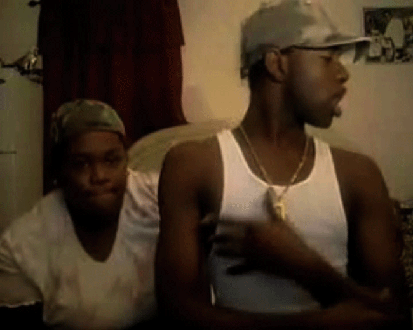
The Berlin-based Serbian artist Oliver Laric is part of a growing community of succesful (not in the least in the contemporary visual arts world) young creative producers (alongside people like Michael Bell-Smith, John Michael Boling and Cory Arcangel, to name just a few) who use digital forms to explore contemporary visual culture and how it is mediated through popular technologies. One of his most interesting projects is ’50 50′ (2007), in which he seamlessly strung together fifty YouTube clips of strangers singing three songs by hip hop artist 50 Cent. The video has received praise around the internet and the art world for its remix of both 50’s music and vernacular video culture. He has now made a recomprised version of the piece (’50 50 2008′) by using all new clips. “The mass availability of videos of people singing these three songs speaks both to the popular appeal of the music and of the act of performing for the home movie camera–thus deepening the initial resonance of Laric’s project” (Marisa Olson).For ‘Touch My Body’, Laric took Mariah Carey’s video for her hit single ‘Touch My Body’ and made a template for chroma-keyed remixes by YouTube users by digitally replacing the background images surrounding the starlet’s body with a flat green backdrop. “The music video begins like many classic pornos: Unwitting nerd rings doorbell, half-naked bombshell babe answers the door, contracted labor assignment is soon interrupted by a romantic interlude with a thumping soundtrack…The song is Carey’s foray into reaching out to the the geek set, and includes references to software upgrades, laser tag, and of course…YouTube! The video millions hits on the video-sharing site and, naturally, all of this makes the piece very attractive to an artist like Oliver Laric, who has a keen interest in digital culture and pop remixes. The artist’s newest piece is an edit of Carey’s video, with everything (the “compunerd,” the house, etc) but the singer masked out in green to encourage chroma-keyed remixes by online vi! ewers. Ironically, Carey’s lyrics speak not only to a mainstream paranoia about surveillance and privacy intrusions, but moreover drops hints about sharing footage online. She sings, “If there’s a camera up in here then it’s gonna leave with me when I do. If there’s a camera up in here then I best not catch this flick on YouTube.” Naturally, this is exactly what Laric is hoping will happen–and no doubt Carey herself. Fame is nothing if not a self-production and Laric’s taken this to heart in leaving the title of the video the same and modifying his YouTube video tags to attract more viewers. His real hope is not that the piece will become an artworld cause célèbre but that the larger public of YouTube surfers will adopt the piece and post remixes of their own. The key point made by removing the superfluous imagery from the video’s 3,000 frames is that, with her “come hither” gestures and the invitation “touch my body,” Carey’s certainly asking for it!” (Marisa Olson). You can a set of remixes watch on Laric’s site. Here’s his Green Screen version.
Also check out his other work, like Message The (2007), in which Laric slices up the video of Grandmaster Flash’s classic “The Message” into its individual words, then rearranges the lyrics in alphabetical sequence (a form of détournement that has been done by other artists as well, see Lenka Clayton’s fantastic Qaeda Quality Question Quickly Quickly Quiet) or (>’.’)>=O____l_*__O=<(‘.’<) (2008), based on thousands of tiny animated gifs that create an ultra-low-res illusion of cinematic movement, generating a barely discernible compilation of clips from a series of hip-hop music videos.